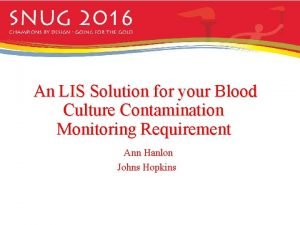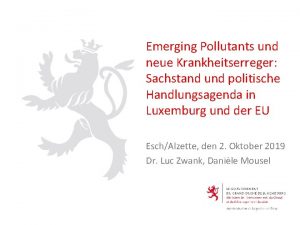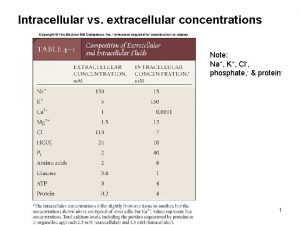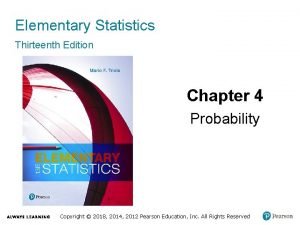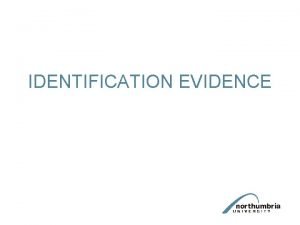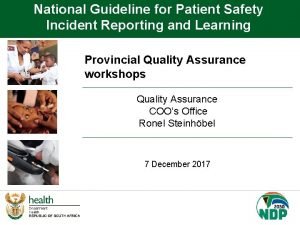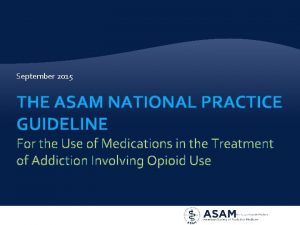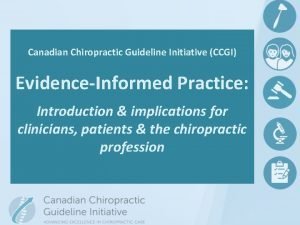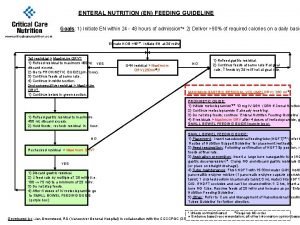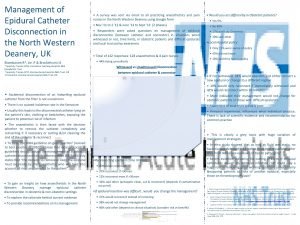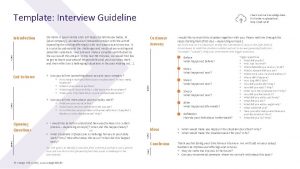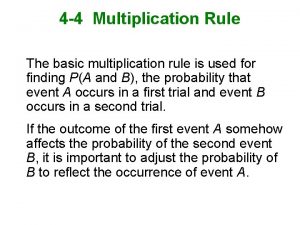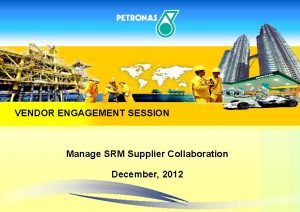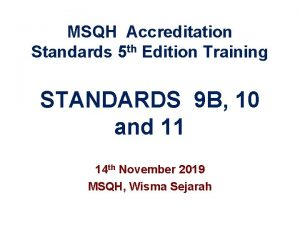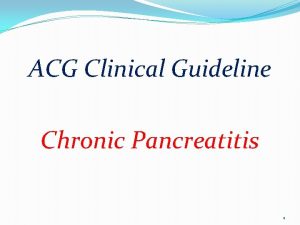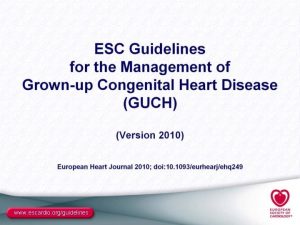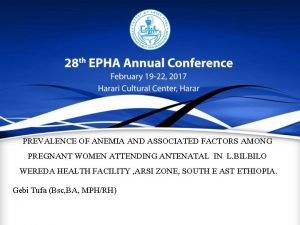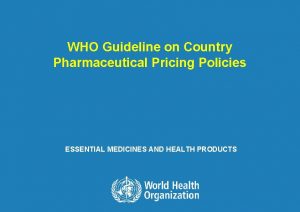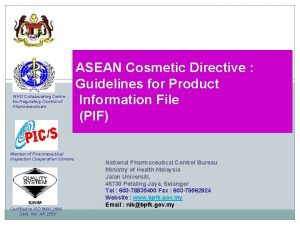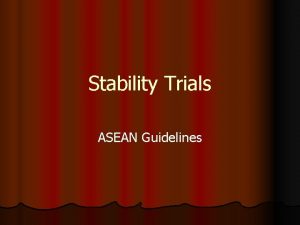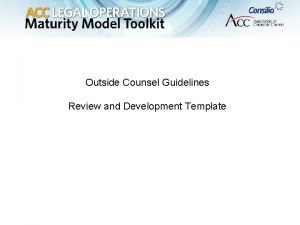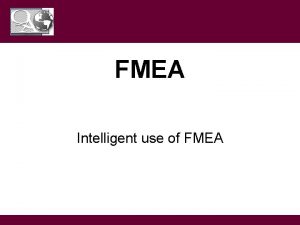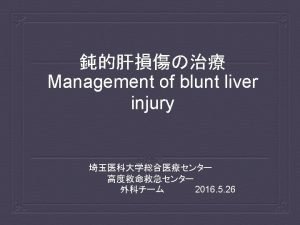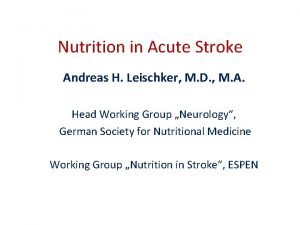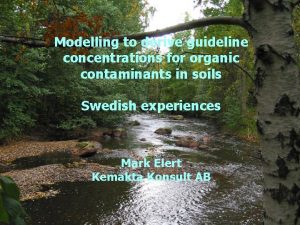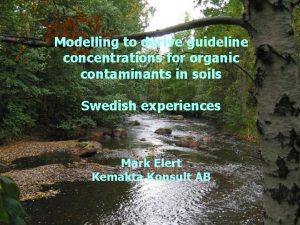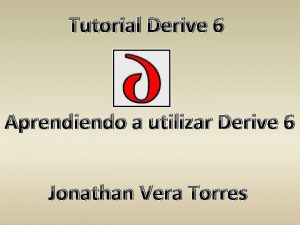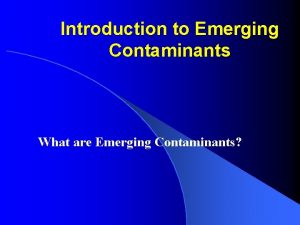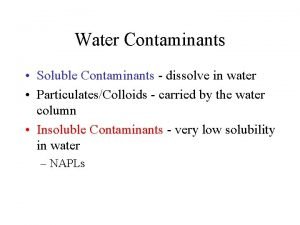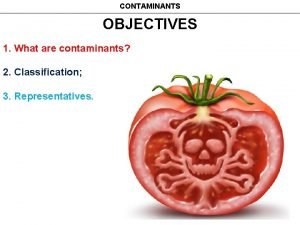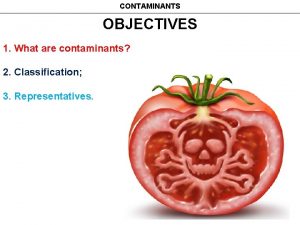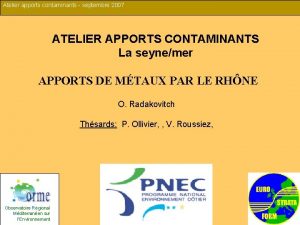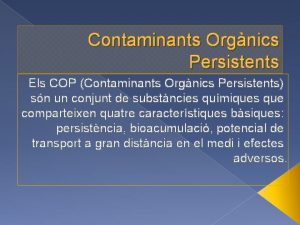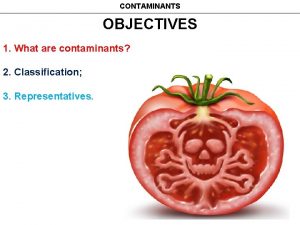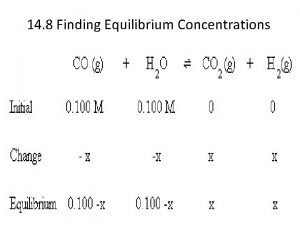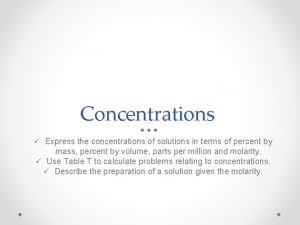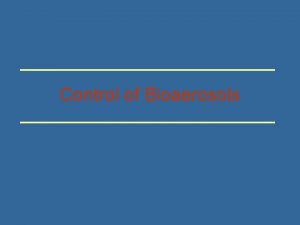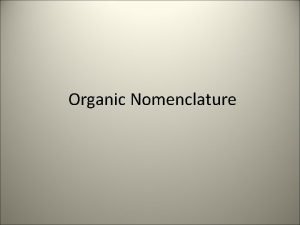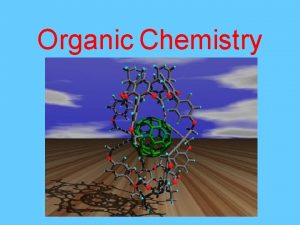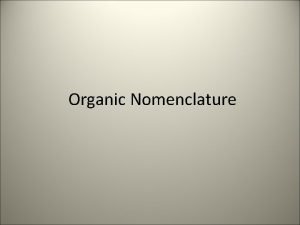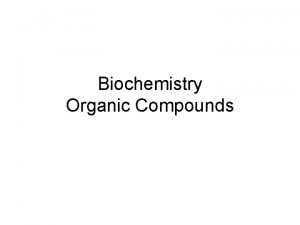Modelling to derive guideline concentrations for organic contaminants





























- Slides: 29

Modelling to derive guideline concentrations for organic contaminants in soils Swedish experiences Mark Elert Kemakta Konsult AB

Content § Soil remediation in Sweden § Overview of the Swedish system for soil guidelines § Recent (ongoing) revision of the guidelines § Special procedures for organic contaminants § Problem areas § Plans for the future

Soil remediation in Sweden § National program for identification of sites § 80 000+ sites § Mining and metallurgy § Heavy metals § Wood treatment § Arsenic and PAH § Dioxin § State funding for remediation of ”old sins” § Many rural sites § New housing § In the main cities § Efforts to increase pressure on industry to remediate

Swedish guidelines for soil § Values for when no risk for health and environment is expected § Not legally binding § Not to be used directly as remediation goals (although that is often the case) § Protective for most sites in Sweden § Over-protective for many sites § Option to determine site-specific values § Using same methodology as for generic criteria § Other methods § Generic methods and models largely based on European (Dutch) and US EPA models

RISK Negligible risk Background Target values No action Significant risk Warning risk SOIL CONCENTRATION Trigger values Intervention values Further investigation and possible remediation Long term objectives ACTION Remediation necessary

History of Swedish guidelines 1997 NV 4638 Generic guidelines. Principals and guidance for use 1997 NV 4639 Development of generic guideline values. Model and data used for generic guideline values for contaminated soils in Sweden 2005 DRAFT VERSION July 2005 Guidance document 2005 DRAFT VERSION July 2005 Model for soil guidelines 2008 New Guidance document for risk assessment will be published. 2008 New document describing methodology and Excelbased model for soil guidance will be published

What is protected? Soil environment § § Human health § Direct contact with soil § Spreading via vapour, plants and groundwater Groundwater § § For drinking water As a resource Surface waters § § Long term risks considered Effects on plants and animals within the contaminated site Effects on aquatic life No increase in concentration of persistent substances

Main changes in new version of Soil Criteria Model § Excel based model: § Basis for setting the generic guidelines § For estimating site-specific guidelines § Changed balance in assessment: § Less conservative estimates of exposure § More stringent limits for health effects and release § New or improved models: § § § transport of vapours to indoor and outdoor air Uptake of organic contaminants in plants Transport to groundwater Release of organics with dissolved organic carbon (DOC) Limits for when free-phase of organic pollutants can occur § Estimation of concentrations in fish, but not integrated in soil criteria

Human health § Models for exposure under generic conditions § Conservative, but not unrealistic estimates of exposure § Sensitive land use (KM) § Less Sensitive land use (MKM) § Age groups § Children (0 – 6 yr) § Adults (7 – 80 yr) § Substances with threshold effects § Most exposed group compared with Tolerable Daily Intake, TDI § Genotoxic substances: § Life-time (80 years) average exposure compared with intake corresponding to an added risk of 10 -5

Exposure pathways § Soil intake § Dermal contact § Inhalation of dust § Inhalation of vapours § Intake of well water § Intake of plants

Calculation of health risk based value C = corresponding concentration in soil: C = TRV / (EXP • DF • FF) § § TRV = toxicological reference value [mg/kg body weight, day] EXP = exposure to contact media [kg/kg body weight, day] FF = distribution in contact media [conc i contact media/conc in soil)] DF = dilution in contact media [conc at contact point/ conc at source]

Integration of exposure pathways § Exposure from all pathways § Only a part of the TDI can be come from the contaminated site § Generally 50% § Pb, Cd, Hg 20% § Dioxin and PCB 10% § Special consideration for substances giving acute health effects: § Arsenic and cyanide

Protection soil environment Quantification of ”critical” effects for an ecosystem : § Serious risk to the environment = Serious risk to ecosystem functions § If most of the species of organisms in the ecosystem are protected, the ecosystem functions will also be protected (Conversely, ecosystem functions are threatened if the species composition is seriously disturbed) § Risk to the environment the probability that more than a certain fraction of the species i are harmed by contaminants § Protection of species at the population level § Data from ecotoxicological effects tests statistical distribution

Protection soil environment § Species sensitivity distributions SSD § Generic guidelines: § Sensitive land use: Protection of 75% of species (NOEC-data) § Less sensitive land use: Protection of 50% of species (NOECdata) § Safety factor method § when only few data available § NOEC or LOEC divided with safety factor (10 – 1000)

”Special cases” § Bioaccumulating contaminants § Toxic reference value (intake in mg/kg body weight) § Exposure model with BCF, eg. soil, plant, herbivore, carnivore § Process data (carbon and nutrient turnover, enzymes) § As a ”check” on SSD § Integrated with other data into one SSD

Organic substances § Chlorinated phenols § Chlorinated benzenes § Chlorinated aliphatics § PCB and dioxins § BTEX § Aliphatic fractions (revised TPHCWG) § Aromatic fractions (revised TPHCWG) § PAH divided into three groups § PAH L low molecular weight § PAH M medium molecular weight § PAH H high molecular weight § Others § MTBE

Groups of PAH § Low molecular weight: § Naphthalene, acenaphthylene, acenaphthene § Relatively mobile: Koc < 5000 § Non-genotoxic TDI § Medium molecular weight : § Fluorene, phenanthrene, anthracene, fluoranthene, pyrene § Intermediate mobility Koc 5000 – 150 000 § Genotoxic. Toxic equivalent factor TEF 0. 0005 – 0. 05 § High molecular weight : § benzo(a)anthracene, chrysene, benzo(b)fluoranthene, benzo(k)fluoranthene, benz(a)pyrene, dibenzo(ah)anthracene, benzo(ghi)perylene, indeno(123 cd)pyrene § Low mobility Koc 200 000 – 3 000 § Genotoxic. TEF: 0. 005 – 1. 1

Distribution of PAH in typical samples PAH L PAH M PAH H Nr Type Samples 1 Gasworks 4 2 Gasworks 82 3 Excavated soil 3 4 Cresote 2250 5 Cresote (1 -40 mg/kg) 1130 6 Cresote 19

Distribution of effective TEF PAH H Most samples have TEF = 0, 2 PAH M Most samples have TEF = 0, 02

Transport of vapours § Simplified Johnson. Ettinger model § Diffusion of vapours in ground § Leakage of soil air into building § Turn over of air inside building § Model for outdoor air § Diffusion of vapours in soil § Transfer to ambient air § Dilution in mixing layer

Uptake by plants § Metals § Empirical uptake factors § Organic substances § Model based on TGD and RIVM work: • Uptake in root, • Translocation to above ground parts • Uptake and release between leaf surfaces and ambient air § Empirical uptake factors • for dioxins and PCB

Leaching of contaminants Grundvatten § Release of contaminants with through flowing water § Enhanced leaching by mobile organic carbon (for organics) § Constant source term § Estimating leaching properties § Equilibrium assumed (Kd-values) § Metals – Conservative empirical values § Organics estimated from water-octal distribution coefficients (Koc) and content of organic carbon in soil

The effect of mobile organic material § Mobile organic material in soil § § Sorption on dissolved organic matter or very small organic particles Important for pollutants with very high Koc (log Koc > 4 -5)

Contamination of well water § Simple model that estimates the amount of dilution in the groundwater zone § Sorption, degradation or evaporation not considered § Protection also of groundwater resourced § Criteria for groundwater 50% av drinking water guidelines § Sensitive land use at site § Less Sensitive land use 200 m from site

Protection of surface waters § Protection of aquatic life in surface water recipients § Dilution of release into a small stream (30 l/s) § Criteria for surface waters: § Metals and persistent organics • Deviation from background/ambient levels § Other contaminants • 50% of effect based criteria • Proposed EQS (EU, Sweden) • Data from Canada, the Netherlands

Recognised problems § Very soluble substances and DNPL § Guidelines for groundwater more useful than for soil § Volatile substances § Assumption of infinite source not valid § May lead to overly conservative values § Petroleum hydrocarbons § Suitable division into TPHCWG fractions § Difficult to relate guidelines to different analytical methods § Analysis methods for aromatics § Persistent Organic Pollutants § Background levels (exposure, in the environment) § Local or large-scale problem?

Guidelines for other media § No remediation oriented guidelines available: § Groundwater • Proposed values for petroleum related contaminants § Sediments § Surface waters § Leads to use of criteria from other countries § The Netherlands § Canada § USA

Guidelines for petroleum related pollutants in groundwater Exposure pathways for groundwater Drinking water Surface water Irrigation Evaporation Wetlands Well Oil Intrusion into buildings

Future § New guidelines and soil criteria published in late autumn § New guideline for risk assessment § Continued work with updating guidelines and criteria § Guidelines for other media
 Common blood culture contaminants
Common blood culture contaminants Grundwasserreinigung emerging contaminants
Grundwasserreinigung emerging contaminants Cl extracellular concentration
Cl extracellular concentration 5% guideline for cumbersome calculations
5% guideline for cumbersome calculations The turnbull guidelines
The turnbull guidelines Patient safety incident report form
Patient safety incident report form Asam national practice guideline
Asam national practice guideline Canadian chiropractic guideline initiative
Canadian chiropractic guideline initiative Enteral feeding guideline
Enteral feeding guideline Disconnected epidural catheter guideline
Disconnected epidural catheter guideline Interview guideline template
Interview guideline template Formal multiplication rule
Formal multiplication rule Srm process flow
Srm process flow Msqh standard
Msqh standard Hrayr shahinian
Hrayr shahinian Acg chronic pancreatitis
Acg chronic pancreatitis Parts of haircutting shears milady
Parts of haircutting shears milady Escardio guideline
Escardio guideline Anemia in pregnancy guideline
Anemia in pregnancy guideline Who guideline on country pharmaceutical pricing policies
Who guideline on country pharmaceutical pricing policies Aki kdigo
Aki kdigo Pertanyaan anamnesa psikologi
Pertanyaan anamnesa psikologi Bpfk cosmetic guideline
Bpfk cosmetic guideline What is a guideline for hoisting a hoseline?
What is a guideline for hoisting a hoseline? Autoanamnesa
Autoanamnesa Asean stability guideline
Asean stability guideline Sample outside counsel billing guidelines
Sample outside counsel billing guidelines Fmea guideline
Fmea guideline East guideline
East guideline Guideline clinical nutrition in patients with stroke
Guideline clinical nutrition in patients with stroke
